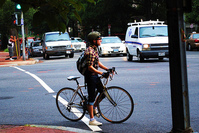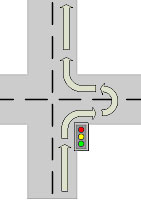What’s our bicycle “social contract”?

Photo by fromcaliw/love on Flickr.
With the frequent calls for cyclists to “start behaving,” it’s clear that a number of people driving and walking are unsettled by the conduct of at least some people on bikes. But people in cars speed all the time, and people walking cross against the light, and neither generates as many newspaper letters to the editor. What is the difference?
One explanation is that people naturally notice infractions by others on different modes more than those on the same mode. People driving tend to see misbehavior by people walking and cycling rather than from other people driving, for example. Since relatively few people ride bicycles while a great many drive, the outraged letters would skew toward misbehavior by those on bikes and away from that by people in cars.
Felix Salmon proposed another interesting explanation a while back. Basically, he argues that we’ve developed a clear understanding of what to expect from people walking and driving generally, but lack that consensus for people bicycling:
The trouble all starts when you drop bicyclists into the mix. At that point, a whole new set of combinations comes into play, and as a city we haven’t worked out how to make them work. In other cities, especially in places like Copenhagen or Utrecht, bicycles are ubiquitous and everybody knows how to behave on and around them. But we’re not there yet.
We expect that people on foot stay on the sidewalk most of the time, and cross when there’s a walk signal or an unsignalized intersection, as the law says. We also expect that people on foot sometimes cross against the light if no cars are coming. That might not be legal, but it’s generally commonplace and pretty safe. People driving might not like it, but they tend not to be too surprised when it happens and don’t write angry letters to the editor about it.
Likewise, we expect that people driving will obey traffic signals and stop signs, and not drive up onto the sidewalk. We also expect that people driving may go a little over the speed limit, which can increase the risk of fatal crashes but is generally widespread. Likewise, people driving often don’t stop fully at a stop sign, which adds a small amount of danger but not that much, and so it’s generally tolerated.
But what do we expect from people biking? What should they do that’s legal, and what are they going to do that’s not technically legal, like people crossing on foot against the light or driving a bit over the speed limit?
As Felix Salmon noted, we’re not in northern Europe where people riding bikes are everywhere. There, there are so many people on bikes that if 99% of them behave a certain way, people walking and driving are used to it and will generally expect it. Those that stray outside those boundaries will face criticism.
Here are a few examples of bicycling behaviors that are fairly common, and my opinion about whether they should be part of the bicycle “social contract” or not:
Okay: The Idaho Stop. Basically, people on bikes ought to treat intersections as people on foot generally do. If it’s a stop sign, look carefully, and proceed if it’s safe to do so. If there’s a light, stop, look even more carefully, but it’s still okay to proceed if it’s safe and continuing wouldn’t interfere with any people driving or walking.
Bad: Blowing through an intersection against the light without slowing down. This should go without saying, but some do it.

The “C maneuver.”
Bad: The “C maneuver.” I often see people on bikes approach a moderately busy two-way cross street, then turn right onto that street, merging into the right-moving traffic, then make a U-turn merging into the left-moving traffic, and finally turn right to get back onto the original street continuing along. (Can you come up with a better name for this?)
Good: Riding in the middle of the lane. This is legal but most people riding bikes don’t do it. If you’re traveling on a bike down a street that doesn’t have a bike lane, it’s best to act like a car. Ride in the very middle of the appropriate car lane, as if you were in a car.
Most people on bikes ride on the right edge of the roadway. But this entices the people driving cars to try to pass them in the same lane. And if that person in the car turns right, they might “right hook” the person on the bike. Being in the center of the lane makes you very visible. If it’s a one-lane street, people on any mode probably shouldn’t be traveling that fast. If it’s a multi-lane street, people in cars can go around.
Bad: Jumping the queue when it’s not really necessary. If you’re on a bike, and there’s one car ahead of you at a stoplight with enough cross traffic that it’s not safe to Idaho Stop across, why go around that car only to make the person driving it pass you again? Just wait behind the car, as if you were in a car yourself.
Okay: Jumping the queue when there are a lot of cars waiting. If there’s a lot of traffic, cyclists are going to squeeze up to the front of the line. It’s not necessarily safest and as an individual on a bike you might be best off waiting at the back of the line, but when there will be a fairly long wait to get going again after the light changes, people riding bikes are generally going to move up. That’s not going to be reasonable to stop.
What do you think about these? What other bicycle behaviors should be part of the ideal “social contract” that will allow people on foot, on bikes and in cars to coexist peacefully, knowing what the others are likely to do and not do?
